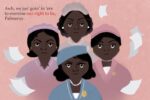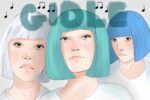CW: Spoilers Ahead
“Bad Hair” dropped on Hulu on Oct. 23, just in time for spooky season. The satirical horror film was written and directed by the creator of “Dear White People,” Justin Simien.
The film features Anna Bludson (Elle Lorraine), a young Black woman who works as a studio assistant in LA for a music network called Culture, a riff off of BET. The network changes leadership, and Anna’s new boss Zora (Vanessa Williams) orders her to get a weave to secure her job. Her new hair brings opportunities and newfound respect from her colleagues, but at a harrowing price. The movie conveys important social commentary about respectability politics and Black influence in music and culture, but its delivery feels flat.
‘Bad Hair’ Covers Important Societal Issues
The exposition of the campy film touches on many key issues surrounding hair in the Black community. These include pain from hair care, rejection of Black women due to their hairstyles and the interaction between hair and media trends. The opening scene of “Bad Hair” shows Anna as a child using a chemical relaxer in an attempt to make her hair more manageable. The relaxer burns her and leaves a bulging scar on her scalp, which many Black women can relate to.
“I felt this visual and audible fright viscerally while watching it play out, reminded of the years I spent relaxing my own hair with chemicals as a kid and into young adulthood,” Aiysha Harris shared in an NPR article.
“Bad Hair” also touches upon the pervasiveness of Western cultural hegemony; Anna reads in a book given to her by her uncle (Blair Underwood) the story of a slave who makes a wig out of tree moss to mimic the straighter hair of white people — only to discover that it is possessed. The story echoes Anna’s, as her weave comes from the same tree and tries to take over her body throughout the movie.
Horror and Comedy Are Poorly Incorporated In “Bad Hair”
Simien uses this disturbing story to represent a real-life horror. “I wanted to point out that, Black folks and Black women, in particular, are just given less choices of how to be in the world. And that, to me, is actually horrifying,” Simien told Entertainment Tonight.
However, the execution of the horror side of the movie does not translate well to the screen. The ominous music that plays over every scene is distracting. As Virgie (Laverne Cox) sews Anna’s weave directly into her scalp, close-ups of spewing blood and excruciating sounds make for an uncomfortable sight. Typically, there is a natural comedy that comes with B-horror films; the movies are maybe not “good movies” but are fun to laugh at. Unfortunately, “Bad Hair” misses the mark at honing the comedy naturally found in the grotesque.
Few movies created by exceptional directors and producers artfully blend horror, comedy and social commentary. Two of my favorite examples of this are “American Psycho” (directed by Mary Harron) and “Get Out” (written and directed by Jordan Peele). Although there are others, I would not put “Bad Hair” into this category. In an attempt to achieve too many goals at once, the movie becomes overwhelming and awkward at times.
“Bad Hair” May Hurt The Audience It Was Meant To Uplift
Simien meant for his movie to be a “very weird love letter to Black women.” However, Vulture writer Angelica Bastien does not believe he delivers on this goal. She wrote that “Simien, from my vantage point, reflects Black men’s own strange, thorny relationship to the beauty rituals of Black women and the intimate spaces in which they take place.”
In her eyes, “Bad Hair” relies too heavily on stereotypes of Black women, portraying it unrealistically. She also notes that its villains are exclusively Black women competing with each other for success and putting each other down.
Furthermore, I find it strange that there is no positive commentary on the culture around Black hair. For a moment, I thought there would be a revelation when Anna goes to get her weave taken out at a Black hair studio. There is a glimpse of the potential community Anna could have had with other Black women, connected by hair care. However, her weave promptly kills all the women in the room. This begs the question — what message is Simien actually trying to promote in his movie?
Important Lessons Can Still Be Gained
In general, the film successfully acts as a lens into the relationship between Black cultural influence and the dominant culture. An interesting dichotomy occurs as Black people are held to an expensive and taxing standard of white beauty, while white people consume their culture as entertainment. “Bad Hair” is timely placed at the vantage point of this issue.
On the influence of Black music on the mainstream, Simien told Variety: “So much of that music didn’t even chart on the pop charts, which is a surprise to me … I just listened to Black music when I was young. In 1989, they had the Black charts, and everything was so segregated.”
Simien’s argument about hair and how it relates to Black popular culture is introduced effectively, but there is no defining conclusion about what it means to the women affected. Black women are the ones who have to experience trauma surrounding their hair and white beauty standards. By the end of the film, we aren’t quite sure what he is trying to say. Ultimately, this begs the question of whether Black men should attempt to tell the stories of Black women’s experiences.
















